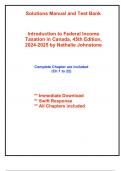Exam (elaborations)
Solutions and Test Bank for Introduction to Federal Income Taxation in Canada, 45th Edition by Nathalie Johnstone (All Chapters included)
- Course
- FT-45
- Institution
- University Of Montreal
Complete Solutions Manual and Short Questions Answers Test Bank for Introduction to Federal Income Taxation in Canada, 45th Edition by Nathalie Johnstone, ISBN13: 9781773792484.... There is no Test Bank for Chap 1 (Full Chapters are included in reverse order from Chapter 22 to 1)...Chapter 01: Intr...
[Show more]



